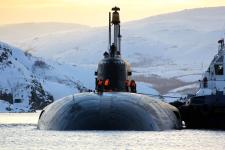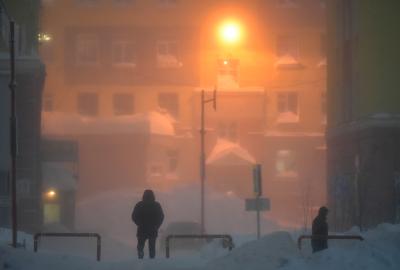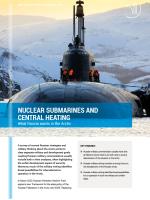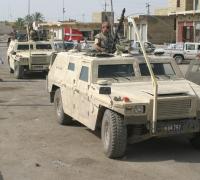Nuclear submarines and central heating

A survey of current Russian strategies and military thinking about the Arctic points to clear separate military and development goals. Leading Russian military commentators usually include both in their analyses, often highlighting the softer development aspect of security. Moreover, much of the military writing identifies broad possibilities for international co-operation in the Arctic.
- Russian military commentators usually insist that all relevant actors need to act with care to avoid a deterioration of the situation in the Arctic
- Russian military writing contains a strong focus on the development of the Russian Arctic
- Russian military writing identifies broad possibilities for co-operation in both the military and civilian fields
In March 2020, Russia’s President Vladimir Putin signed a new ‘Framework for the state policy of the Russian Federation in the Arctic until 2035’. Replacing an earlier document covering the years 2008-2020, the new Framework catalogues the main future interests, aims and tasks relating to the Russian Arctic, as well as the threats and challenges to it. It is complemented by a large number of more targeted strategies and policy papers that have a bearing on the region.
The Framework essentially stands on two pillars. The first is a military pillar, which includes the protection of state sovereignty, Russia’s response to a military build-up by other states in the Arctic and preparations for an increase in the potential for conflict in the region.
The second is a development pillar, which directs attention to such diverse issues as out-migration and population decline, difficult socio-economic conditions, a poor investment climate, an out-dated and inadequate infrastructure, and environmental degradation.
The political thinking expressed through strategies and policy papers forms an important part of the background against which Russian military commentators analyse current and future situations in the Arctic. This study surveys recent Russian military thinking about the Arctic as expressed in the pages of the two leading publications in this field, Voennaya mysl (VM) and Voenno-promyshlenniy kurer (VPK).
From military dangers to military threats
Striking a seemingly optimistic tone, one military commentator writing in the pages of VM in 2020 explains that ‘presently, there are practically no interstate conflicts in the Far North capable of turning into military threats’. Nonetheless, he adds, ‘the likelihood of hotbeds of tension emerging in the Arctic may increase by 2030’.
This assessment is representative of most of these writings. The message is that, while the Arctic is still some distance from the brink of military conflict, all relevant actors need to act with care to avoid a deterioration of the situation. Using key definitions from the 2014 Military Doctrine, Russian military commentators usually point to the risk of ‘military dangers’ growing into ‘military threats’, or the ‘real possibility of the emergence of a military conflict between the conflicting sides’.
The current military-political situation in the Arctic generally is not critical. However, the relationship between the Russian Federation and Western countries is deteriorating, and its future does not inspire optimism.
Russia’s military thinking about the Arctic and its build-up in the region, so the general argument insists, is a response to the West’s aggressive policy, which is forcing Russia to prepare adequate countermeasures. ‘The second Cold War essentially started after the return (i.e. annexation) of Crimea to Russia’, so notes a military analyst in 2016 in VPK, adding that this caused the emergence of a new ‘cold hot spot’ in the Arctic.
Russian military commentators openly admit that much had to be learned anew by the Russian armed forces. ‘Do not shoot at the polar bears’, says a 2016 headline in VPK to an article describing how Russian special operations forces (SOF) had begun preparations for operations in the Arctic domain. A string of later articles makes it clear that since the collapse of the Soviet Union much knowledge has been lost and much of the infrastructure in the Arctic has been left to decay.
In 2016 a seasoned Russian Arctic explorer explained to the readers of VPK that ‘we are talking about preparing the (‘fighter’s) necessary psychological platform. He cannot be afraid of the natural environment in which he has to live’. Similarly, other writers highlighted the need to develop and test new equipment under extreme temperatures and to establish a new and contemporary infrastructure, not only to replace the dilapidated Soviet-era infrastructure, but also to create a larger grid to connect up this vast area in face of the external military challenges identified by the Russian state.
As expected, much of the military focus is on missiles, submarines and ice-breakers, but considerable attention is also being given to the issue of mobility, as it is clear that the available troops in this region are often stretched thin, making it hard to defend. Military planners foresee scenarios in which local units will have to exercise extended autonomy and rely on their own resources while awaiting reinforcements. SOF play a critical role in this, serving as the glue that holds much of it together.
As an indication of this, in April 2020 Russian SOF parachuted over the Arctic from a height of more than 10,000 metres in order to demonstrate a rapid response capability that Russian writers claim to be unique to Russia. Even this demonstration of force, however, failed to impress two high-ranking officers, who, writing in VM in late 2020, regretted what they believed to be ‘a lack of forces, equipment and the necessary military infrastructure’ in the region.
Environment and infrastructure
‘In the Soviet era’, according to a 2016 article in VPK, ‘for a long time questions of ecology and the protection of the environment did not receive any attention’. This has changed, so readers are given to understand, and a later article in VM notes the positive process ‘associated with the solution to ecological problems: cleaning the Russian Arctic of rubbish, eliminating the many radioactive waste sites and organising a system to prevent accidents in sites of oil and gas extraction’.
National security is not just a matter of resisting military threats: it also includes a socio-economic component.
The environmental focus, so a 2017 VPK article adds, is also good for the economy. The writer insists that cleaning up the Arctic could pave the way for much-needed tourism in the region. He points to the island of Franz Josef Land, selected for an early clean-up and the site of Russia’s northernmost air base at Nagurskoye, as a prime destination for Arctic tourism.
The Northern Sea Route (NSR) is central to the economic development of the region and is rivalled in importance only by the prospect of the increased exploration and extraction of fossil fuels and minerals. ‘The disruption of sea transport [and of] the Arctic transport system in general (…) may have catastrophic social and economic consequences, causing an immediate threat to the lives of people of [the Arctic]’, so warned a 2017 VM article. Since the publication of this article the importance of the NSR has only increased, as reflected in Putin decreeing a sharp rise in the annual tonnage in 2018, from 21 million tonnes in that year to a minimum of 80 million tonnes in 2024. The figure for 2020 was a more modest 33 million tonnes.

Russian writers openly draw attention to the poor state of the supporting infrastructure, both on-site and across the country. Much of the focus is on the railway system that serves the Arctic ports for both military and commercial purposes. This includes, according to a Russian expert interviewed by VPK in 2019, the establishment of a Transarctic railway line along the breadth of the Russian Arctic. In his optimistic assessment, it may take some ten to twelve years to complete once a decision has been made.
A feature article on the NSR in VM in 2020 confirmed the central importance of this transport line alongside access to ‘the riches of the Exclusive Economic Zone and the continental shelf of (Russia)’. Both have implications for sovereignty and development. As far as the NSR is concerned, the economic dimension relates to the use of the supporting infrastructure, as well as possible compulsory on-sea services, including ice-breakers and pilots.
DIIS Experts



